Special Hobby 1/48 He 115B
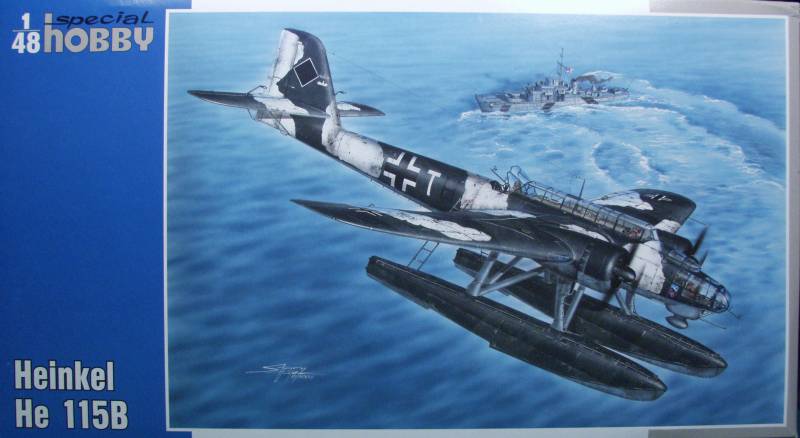
History:
The He 115 was one of two aircraft built to meet a 1935 RLM requirement for a replacement for the He 59. The other competitor was the Ha 140. The He 115 was chosen as a result of the Ha 140 suffering structural damage during service trials. The original contract had been for three prototypes. Various changes were made to the prototypes, including several different nose configurations. During the course of the summer of 1938 10 pre-production He 115A-0 were completed for service evaluation. These differed from the prototypes in have a much simplified float bracing layout which eliminated a profusion of bracing wires for a simplified series of struts. The initial series model the He 115A-1 entered production in January 1939, this being primarily a torpedo carrier but having provision for three 551 pound bombs in the weapons bay as an alternative load and hard points on the wings for two additional SC 250s and their racks. The A-2 variant was the export version which were sold to Denmark and Sweden. These varied only in operational equipment. The final A variant was the A-3 which featured updated radio equipment and an improved weapons release system.
------------------------------------
The B series came about as a result to attempt to increase the versatility of the floatplane by enabling it to carry a greater variety of equipment and offensive loads. Some structural strengthening was undertaken and the overload fuel capacity was increased. Ten pre-production samples of the B-0 variant were built. In December of 1939 production of the B-1 variant was started and it could be equipped with one of several field conversion sets allowing it to carry reconnaissance cameras, bombs or aerial mines. Since the subject of this kit is the B series The C series was basically the same airframe with a 15 mm cannon mounted under the nose and a fixed aft firing 7.9 mm machine gun mounted in the tail of each engine nacelle for use against pursuing fighters.
By late summer 1940 the obsolescence of the torpedo bombing floatplane could no longer be ignored. It's tasks could be performed more effectively by the faster and less vulnerable shore based aircraft that had been found to be amendable to the torpedo dropping role while longer ranging and larger capacity flying boats could undertake the maritime patrol and mine laying roles. Thus production of the He 115 was phased out bring total deliveries to 138 machines including exported aircraft but excluding prototypes. Although suffering obsolescence during much of its service life, this floatplane established an enviable reputation for reliability. It handled well both on the water and in the air, it could fly safely at high loaded weights with one engine out and its robust construction enabled it to absorb considerable punishment, both from enemy fire and heavy seas.
The kit:
OK, so what variant is the kit ? All of the references I have and all the photos I have found identify the aircraft equipped with the nose cannon as shown on the box art as a C model. The kit states it's a B model and two of the markings options show the nose cannon and identify them as B models. In doing some additional research I did find some photos in a later publication that identified B models with the nose gun so maybe some were retrofitted and in Special Hobby's defense I found a profile of the plane on the box top which is identified as a B model. Which is right, I don't know but if you want to model a specific airframe best check your references.. That said, on with the review...
The Special Hobby kit comes in a rather large top open tray type box with nice art work on the top. Inside the box all of the sprues are contained in a large resealable bag. The clear parts are contained in a separate resealable bag. Two small zip lock bags contain resin parts. The sprues are molded in a gray color and the surface finish is fairly typical for limited run kits with some very light surface scratches from the less than highly polished molding dies. I did find a few surface irregularities on the fuselage and wings but nothing a little sanding or a little filler won't fix. This should not be an issue if a primer is used before the final paint colors are applied. The parts feature recessed panel lines, rivet and fastener detail. The panel lines are a nice size for the scale and are uniform and regular. Some flash is present and it has typically heavy sprue attachment points. There are some ejector pin marks but it doesn't appear that any of them will show when the kit is assembled. Parts with a parting line will require some cleanup. The interior has a nice level of detail with a total of 86 parts including all the bulkheads and floors and PE parts including seat belts and harnesses. This should please most builders and at least some of it will be visible with all the clear crew glazing. The control surfaces are are molded in the neutral position.
The engines are provided as a one piece resin casting, The instructions show adding push rods to the engine but the material for this is not supplied, with these and some ignition wiring the engines should really stand out. The instructions show the engines mounted upside down with the air intakes on the bottom but an errata sheet notes the error and shows the correct mounting. The propellers are provided as a hub with separate blades and the blades do have an alignment pin to provide the correct pitch angle.
Step 11 in the instructions begins with a warning to test fit the float halves carefully as some minor fit problems may occur mainly in the front section. This tells me there will be issues but we'll see when we get to the test fit stage.
OK, lets look at the sprue shots.
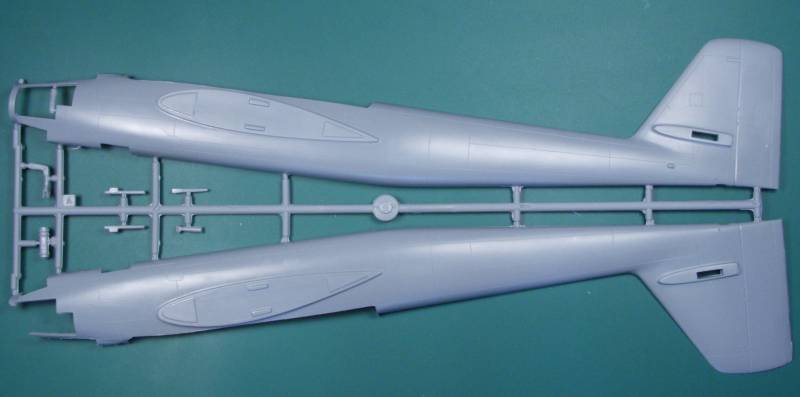
You may have missed it in the first photo but there is some shipping damage visible, the problem encountered when all the parts get shoved in one bag and shipped half way around the world. Fortunately the piece that broke off was still in the bag and it was nothing that a little Tenax couldn't fix. This photo also give a good representation of the flash present on many of the parts, not all that untypical for short run kits.
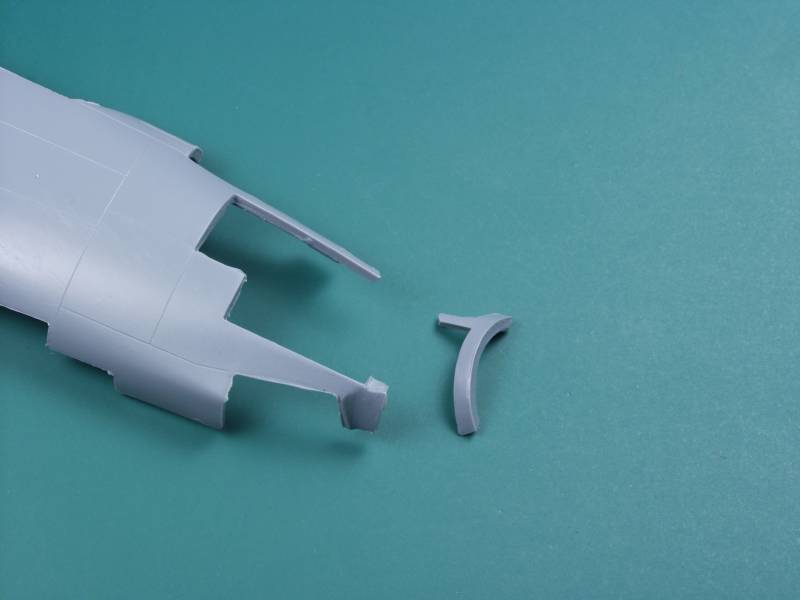
Obviously there are two of the next sprues but they are identical so only one is shown. The reason for the opening in the upper wing half is to provide for the rear facing machine gun that the C model had you can see the standard cowl on the left and the extended one for the machine gun on the right.
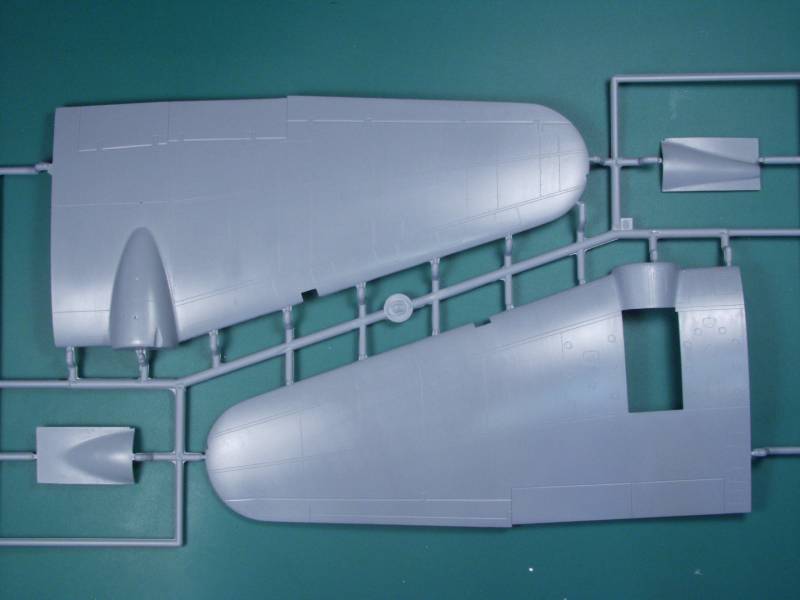
There are two each of the sprues shown below as required to end up with four float halves. As a result of this you also end up with parts for four horizontal stabilizers. If you look carefully the horizontal stabilizers are not exactly the same, more on this later.
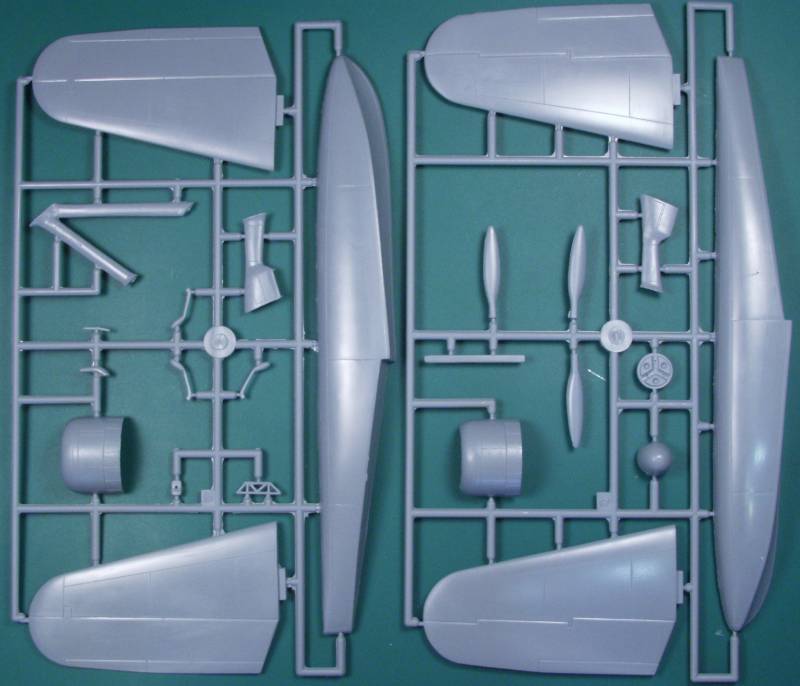
There are interior fuselage wall panels which do a good job of hiding ejector pin marks.
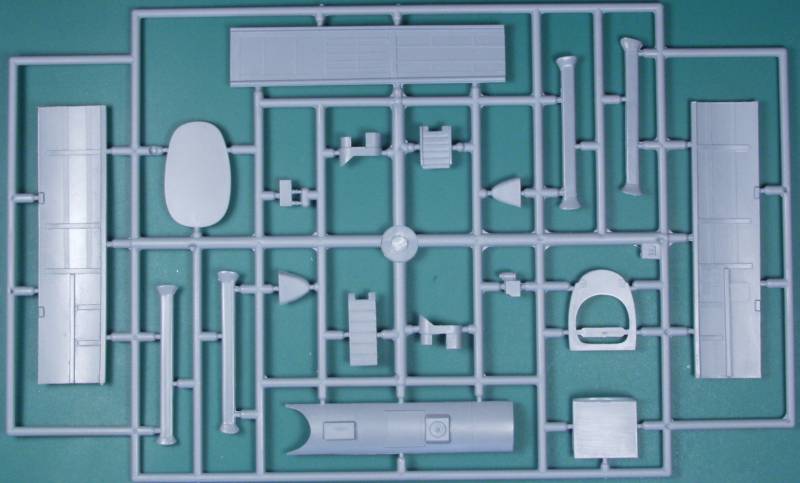
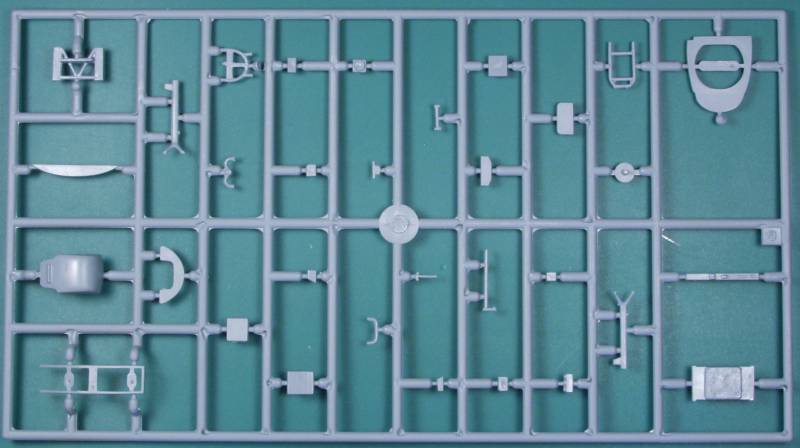
One bag of resin parts contained the engines and they are very nicely molded with no defects I could find. These should look great painted up with push rods and some ignition wiring added. The bag also contained spare ammo containers, machine guns and barrels and the parts for the nose fairing which contained the 15 mm cannon and the barrel for it. Two of the barrels are meant for the C variant with the machine guns at the rear of the engine cowlings.
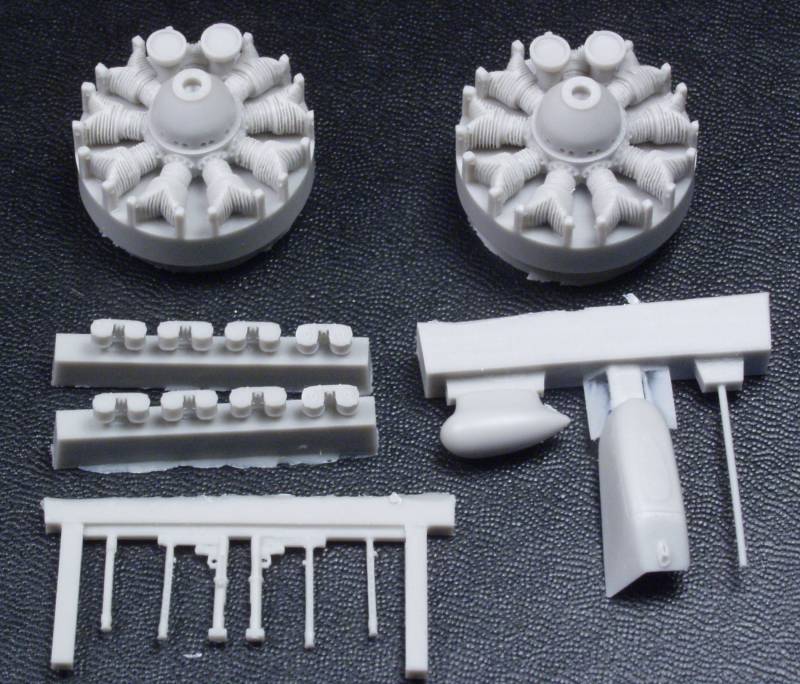
The other bag contained one side bulkhead, which must have been added to cover an oversight as the other matching bulkhead part is injection molded, two platforms that go in the interior, radios and some miscellaneous interior parts.
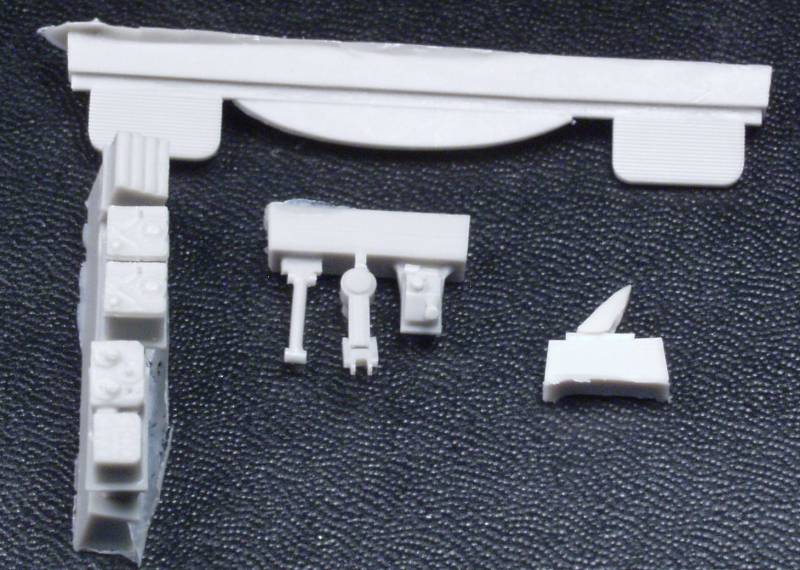
The PE fret contains belts and shoulder harnesses, instrument panels which are used with the film below to form a sandwich. The long pieces are splash guides which get added to the top portion of the floats. There are also gun sights, a control actuator and some levers for the side console in the pilots section. Two ladders are supplied but in my opinion this would be better done replaced with some small gage wire. Photos show these as cables with rungs mounted between them.
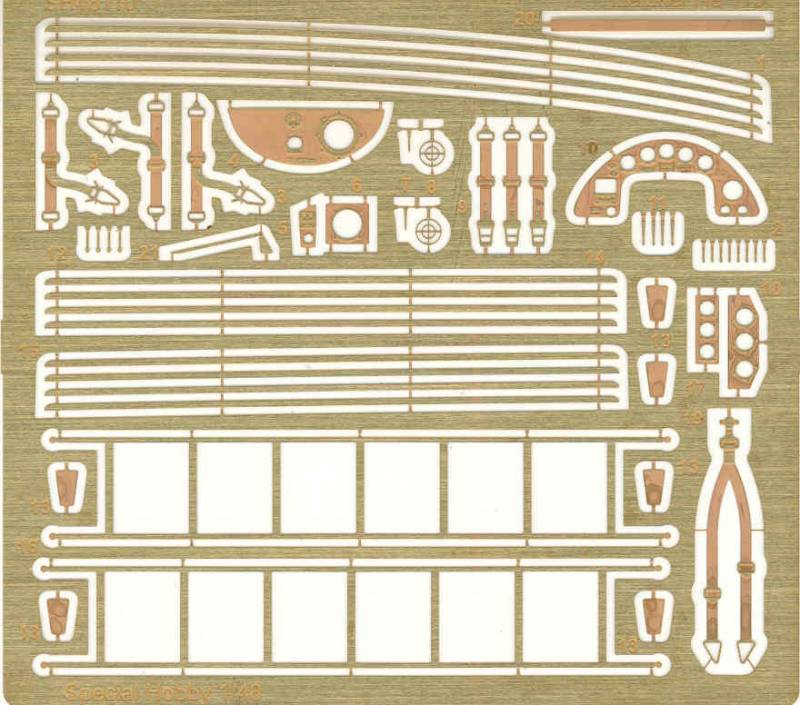
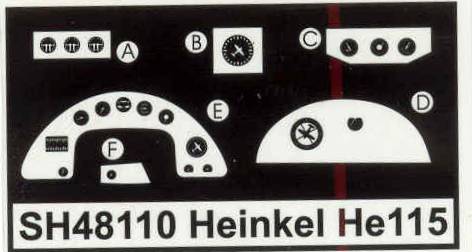
The clear parts are relatively thin and clear with only a small amount of distortion and they have nicely raised frame lines which should make for easy masking and thankfully Eduard does make a mask set for it.
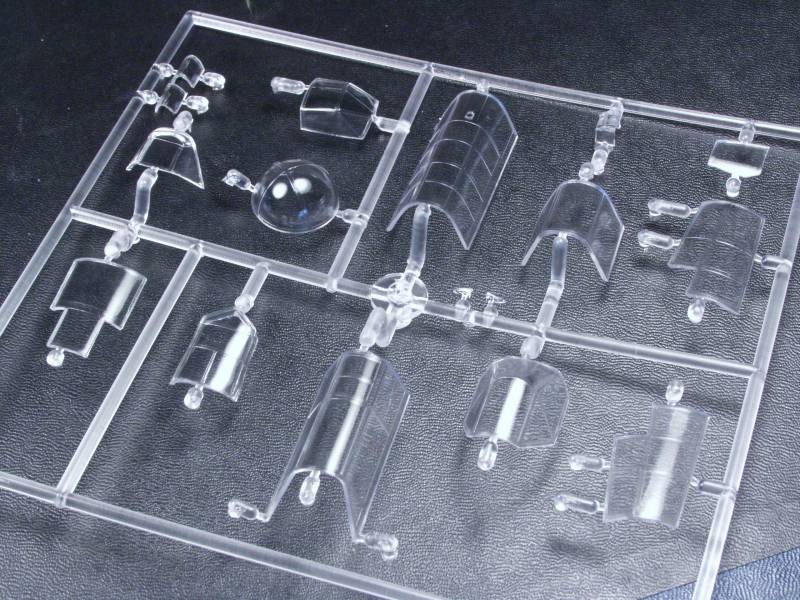
The decals contain marking for three aircraft, one in traditional splinter and RLM 65 under surfaces and featuring areas of temporary white winter finish and including tail markings believed to indicate operations against convoy PQ-17. The second features traditional splinter on top but with temporary black under surfaces and the white on the national insignia roughly painted over and the third is an aircraft that lost a float and sank after a hard landing and was recovered in recent times and will probably be restored. The decals are printed by Aviaprint and appear to be thin and in register except for the white outlines around the multi piece swastika and the white surrounds on the fuel markers. There is very little excess film around the outsides of the various markings. The white appear to be a bit translucent, not sure how much and my set had a couple of dents in it from being hit by parts in the kit in spite of being in a separate bag.
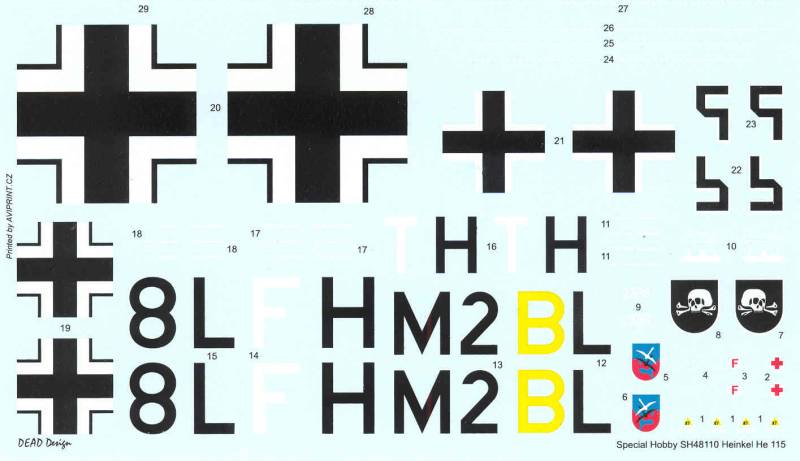
he instructions are 4 A4 sized sheets folded and printed to form a booklet 16 pages long. The first page has history in English and Czech, the next two feature parts maps and symbols charts. The assembly steps begin on page four and continue through page thirteen in twenty steps. The line drawing illustrations should be easy to follow. The last three pages are the painting and marking diagrams. Colors are called out by RLM numbers where applicable and generic names and paint reference numbers are to Gunze.
OK, so how does it fit ? Well let me tell you it was a bit of a PITA to test fit. To start with my fuselage halves were warped making taping it up a bit testy but I did manage, if a dip in hot water doesn't solve the issue it will also make gluing it up a bit tedious, I also found that when the upper surface was aligned I had a bit of a step on the bottom. A few styrene tabs applied before hand might be helpful here. When the forward portion of the fuselage was placed flat on a surface the tail bowed upward, both fuselage halves were the same in this respect. The next photo shows the upper fuselage seam, there is not much contact area ahead of the cockpit. Even with tape the seam wanted to open back up.
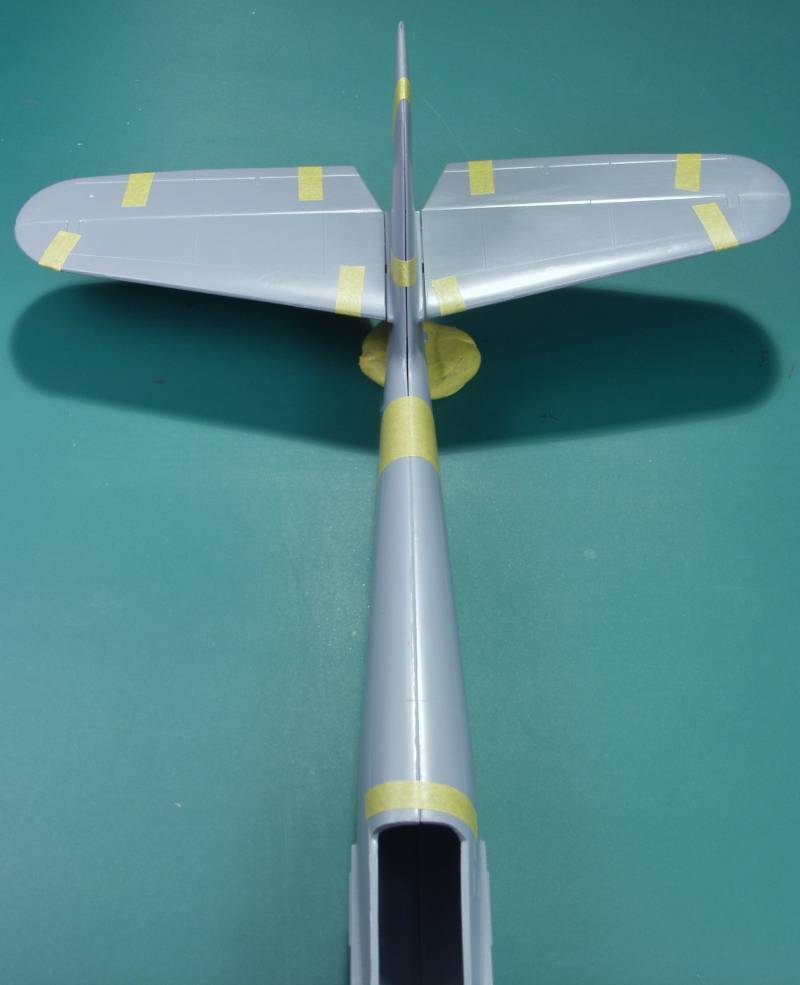
The wings fit pretty well and the seams will be smaller if the mating surfaces are sanded lightly but I did not do that for the test fit.

I was concerned about how well the cowling panel would would fit the opening in the wing. There are no tabs or stops to hold it in and for that reason I recommend you install this before gluing the wing halves together, Initially the panel was too large and it required a light bit of sanding to get it to fit. Go easy here or you'll end up needing filler. As it was at least the one I tried went in and fit well after a bit of sanding along the edges.
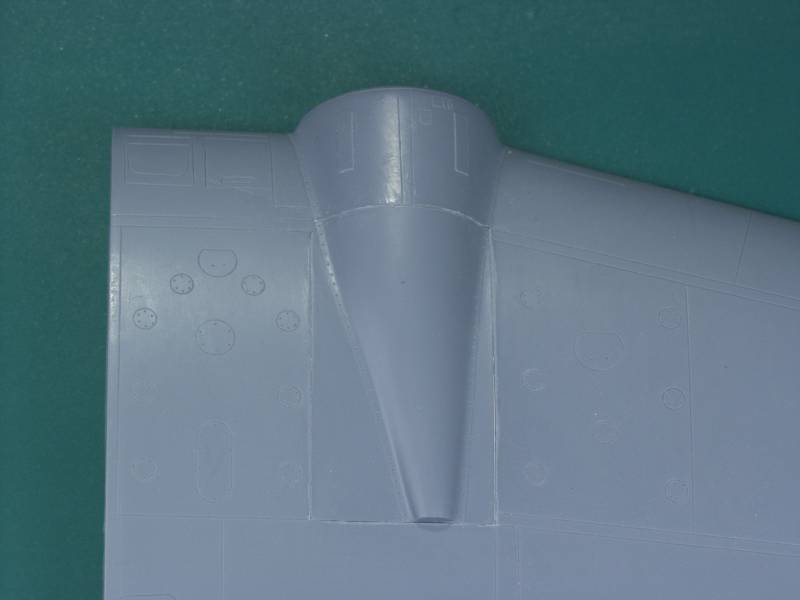
I mentioned earlier that you end up with two sets of horizontal stabs. One set has the elevator hinge line straight across the other has it stepped. None of the references I have show anything but a straight hinge line so I have no clue for what the other set is intended. It's probably just as well as the stepped set has a very rough surface finish, almost feeling like sand paper when you rub your finger over it. None of the other kit parts were like this. The horizontals stabs halves fit together well and again the seams would be better with a light sanding on the mating surfaces. As far as how they fit to the fuselage, that's another story. The holes in the fuselage were too small and needed opening up a bit but even then they still did not provide a good fit to the fuselage. It appeared to me that the ends of the stabs tapered to the middle so some sanding and carving will be need to achieve a better fit and I suspect some filler will also be needed.
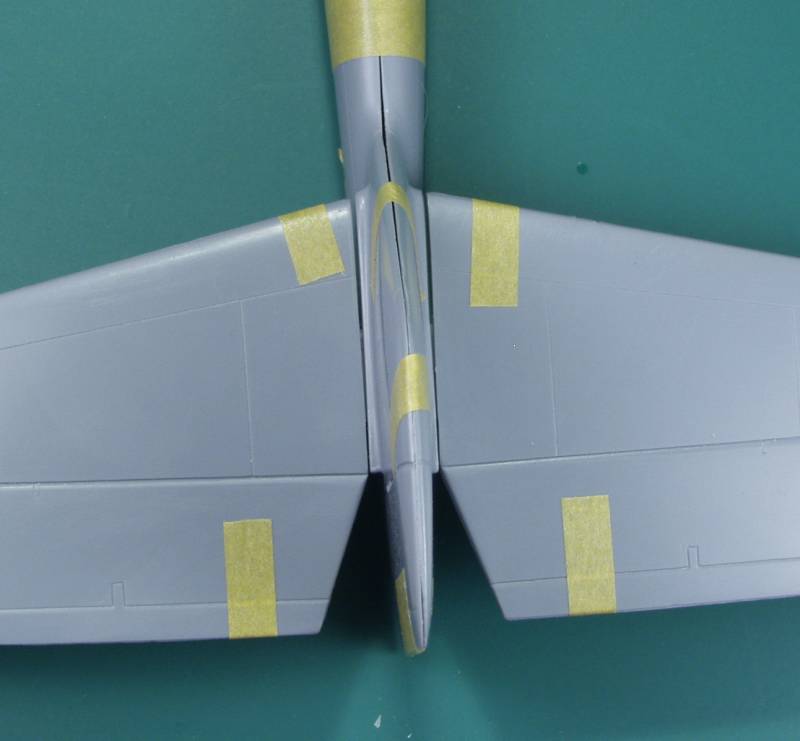
My next bit of frustration occurred when I tried attaching the wings to the fuselage. As seen in the photo below the fuselage has alignment pads molded to the wing root.
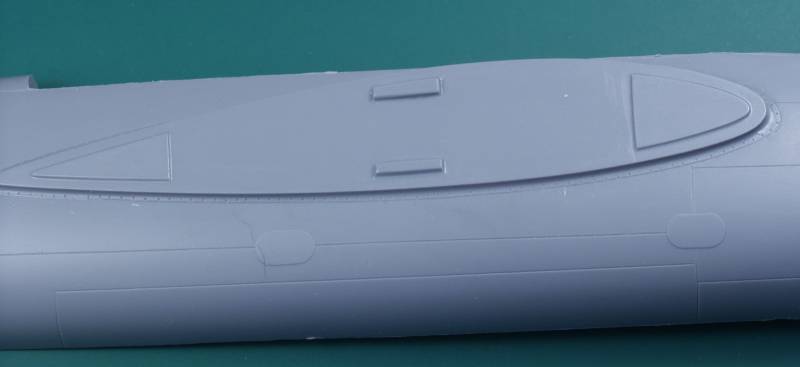
These only protrude about 1/16" or less and trying to fit the wing and tape it in place was a test of wills that for the most part I lost. The wings are just hollow on the ends and the pads don't stick out far enough to help hold the rather heavy wings. I think even gluing would be difficult as it takes two hands to hold it firmly in place. I think at build time I will either build up the pads or maybe drill some holes around the edges of them and glue some styrene rods to help with the alignment. Best I could do was to get one wing positioned long enough to get a photo. Top side...
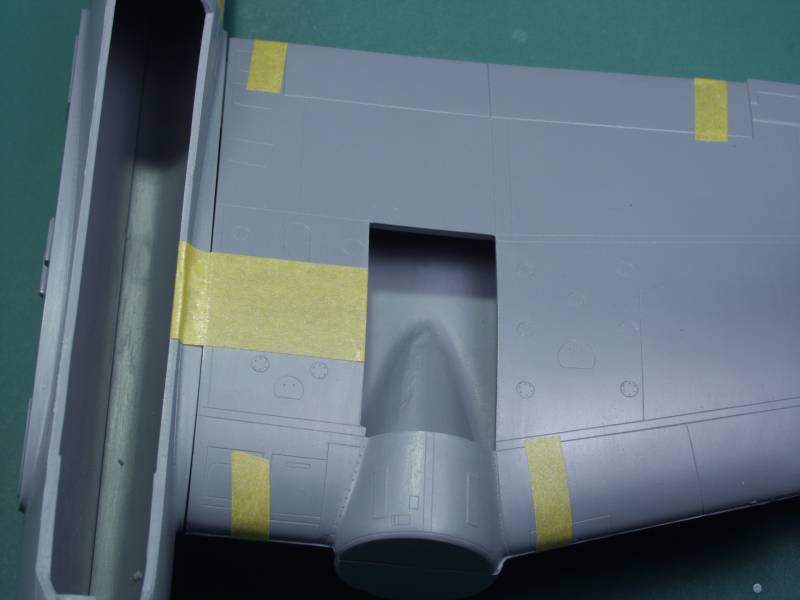
And bottom side... this also shows the bottom fuselage seam with its slight step.
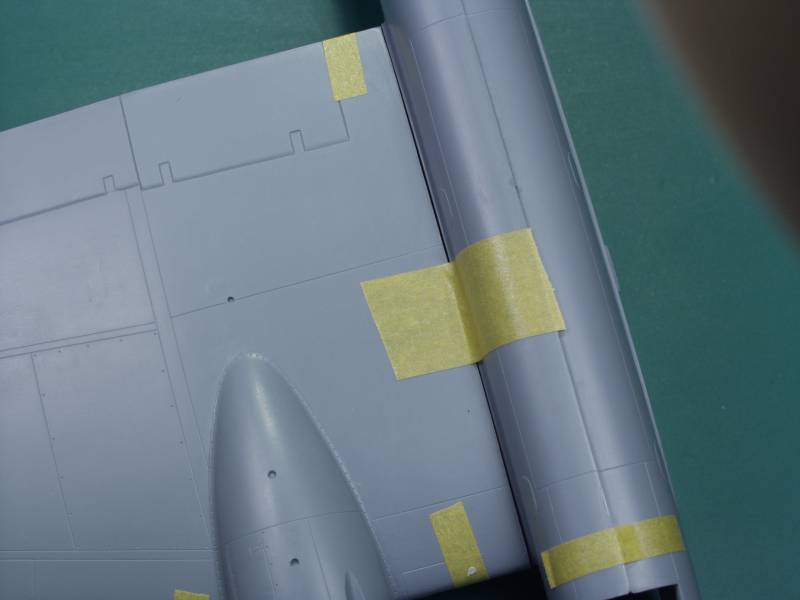
In one build I found on line the author glued the wings and stabs to the fuselage before gluing the fuselage together. I think this would make the last step difficult due to the size and weight on the wings but whatever works I guess.
I did tape up the floats to see what the note in the instructions was all about as the instructions warn there is a fit issue with the floats. First photo shows the top side seam...

Everything lines up well and the seam is satisfactory but on the bottom side we have a major step...
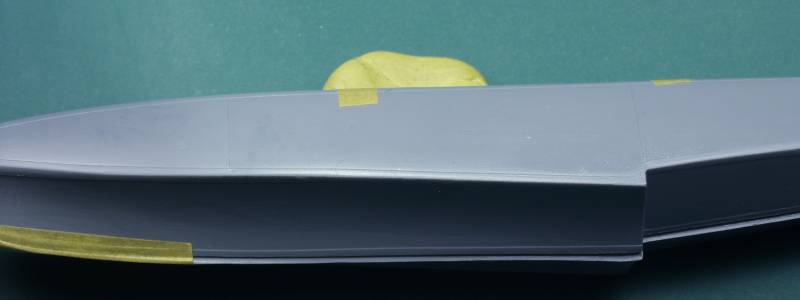
Both floats are the same, it's like one half is larger. Probably several ways to deal with this but since it's on the bottom I'll probably just sand down and reshape. Since the float struts attach to both the wings and the fuselage I didn't try fitting them due to the wing fit issues.
The engine cowlings fit together well but they are the only parts that has an ejector pin tower inside that needs to be removed to allow the engine to fit. And wonders will never cease the resin engines actually fit without needed to be sanded down, in fact they were just a tad undersized to fit snugly for a photograph so I wrapped some tape around the casting to achieve a snug fit.
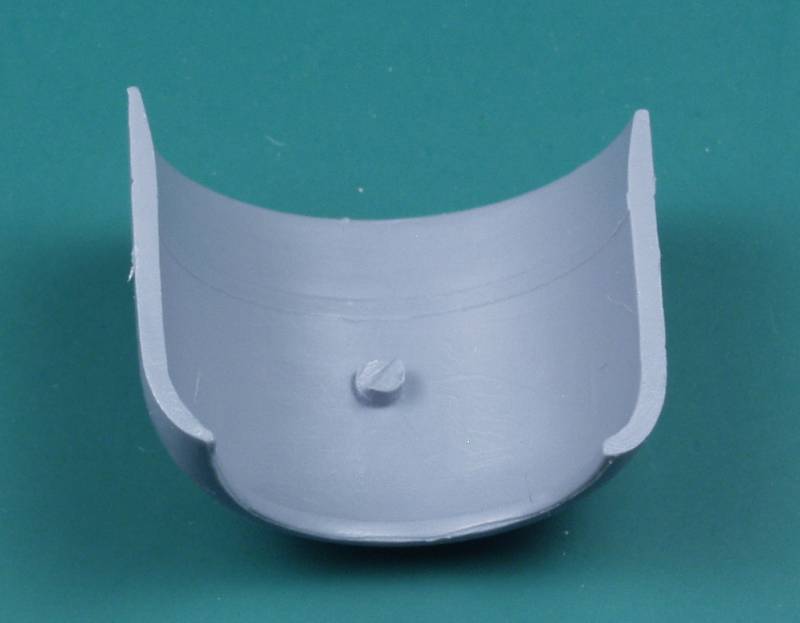
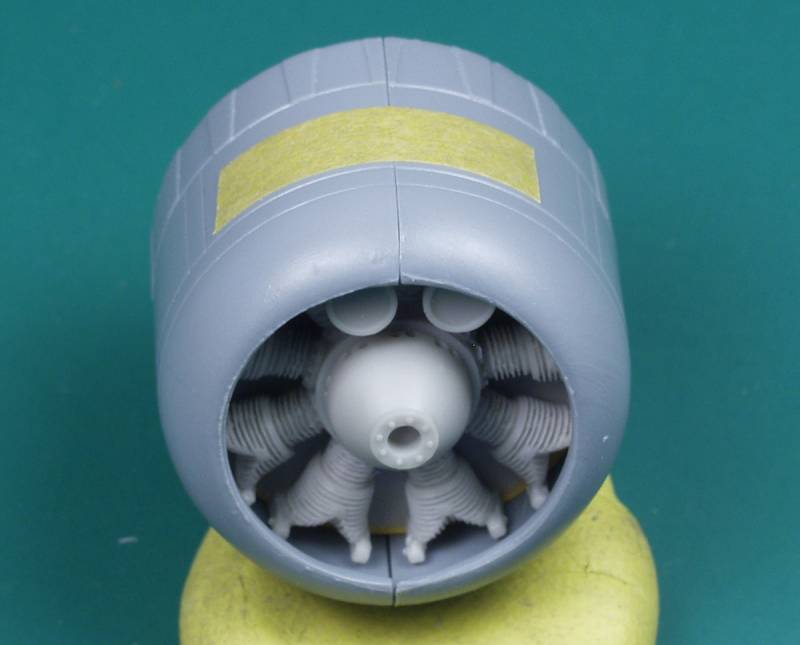
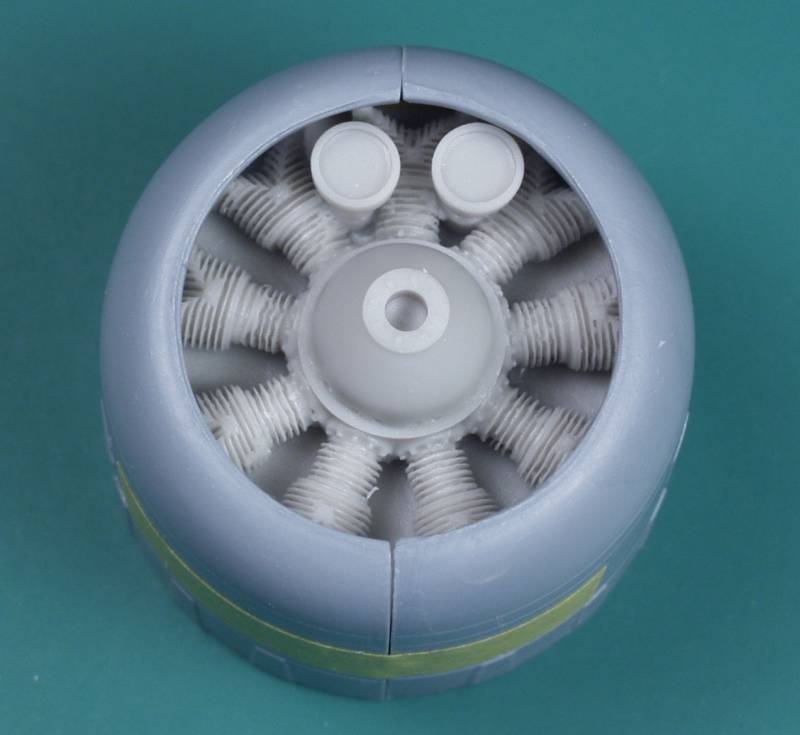
The engines fit to the front of the cowl with a butt joint so it's up to you to get it aligned properly.
OK, some parts fit is dodgy, some test fitting, sanding and filling required. I know that all of this sounds quite negative but the fit issues are quite typical of the issues often found on short run kits and while they can be challenging at times think of it as skill building. If you want something that falls together get the Tamiya kit ! What's that, you say Tamiya doesn't make one, looks like if you want one you need to do some work. The way I see it issues aren't problems if you know about them in advance and that's why I don't gloss over them.
The issues don't dampen my enthusiasm for kit and some of the issues I had trying to hold things together with tape will be much easier with glue. Seams that don't look all that great will look much better with the mating surfaces lightly sanded and solvent welded together and not just held with tape. I hope the kit sells well, they have already released a second version with decals for the export versions. Now if they will just do some of the other seaplanes like the Do 18 or the Bv 138 I will be a happy camper !
Conclusion:
My 2¢ worth...A typical short run kit with all the usual issues of fit and the like but not a big challenge for those who build kits of this type. I'm pleased to see a kit of this in 1/48 scale as the 1/72 scale kits of this aircraft were getting a little long in the tooth. Hopefully it will sell well and we will see some other seaplanes in the future. Not Recommended for beginners but it should be no problem for those with experience with short run kits.
Thanks for looking in !
